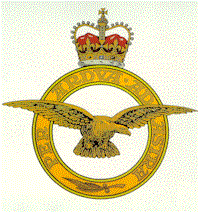
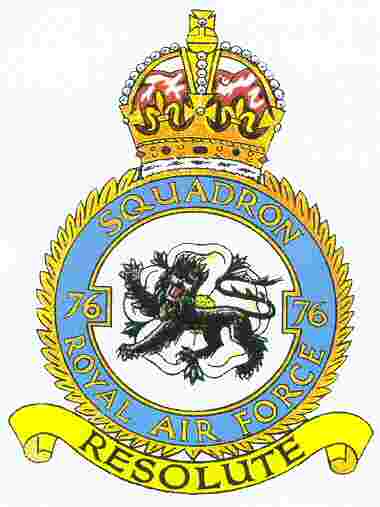


WHITFIELD, Clarence Emerson
Sergeant pilot 923812
76 Squadron, Royal Air Force Volunteer Reserve
Clarence died on a bombing raid over Germany on
Wednesday, 13th August 1941. Aged 21
Clarence was the son of Charles and Annie Whitfield of Langenhoe.
The picture is provided by his sister Mrs. May of Langenhoe.
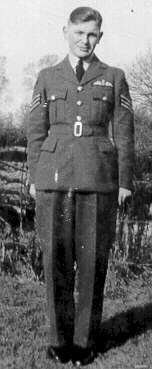
The family originally came down from County Durham, where the father had been a miner. He came to do the tunneling work associated with the construction of Abberton reservoir.
Clarence took a job with the Post Office pre-war. His brother Ron joined the Militia in 1939 and transferred to the Royal Signals on the outbreak of war. Ron served in Europe after D-day and ended the war in Holland. Clarence joined the RAFVR and was posted to 77 Squadron initially.
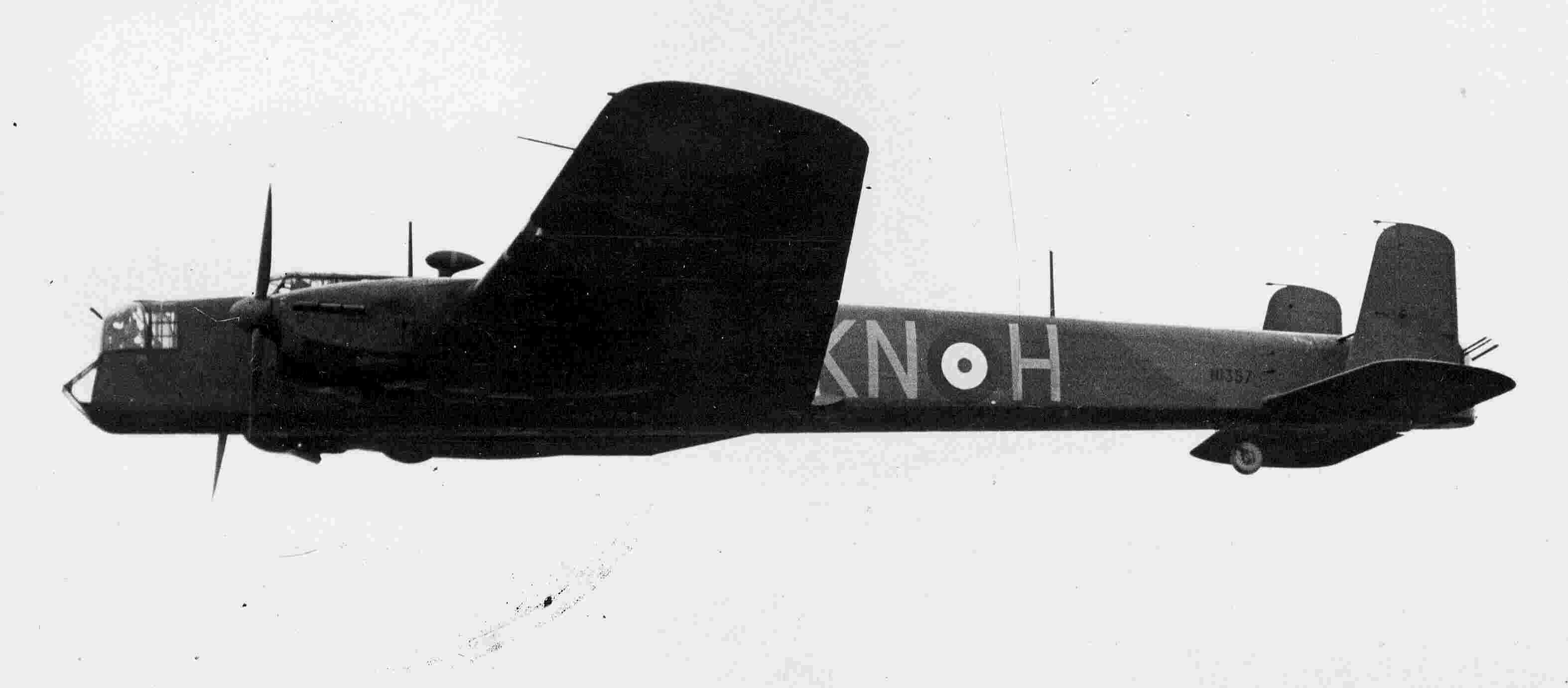
Whitley bomber of 177 Squadron "(c) Crown Copyright/Mod"
Clarence flew, as a crew member of a Whitley V bomber, in a number of sorties through May and early June 1941. They were all night raids
2nd May Hamburg
6th May Hamburg
8th May Shipbuilding yards at Bremen
9th May Chemical factory at Ludswighaven
11th May Barrack Square at Bremen
15th May Dieppe
10th June Brest Harbour with attacks on the two sister ships, the battlecruisers Scharnhorst and Gneisnau.
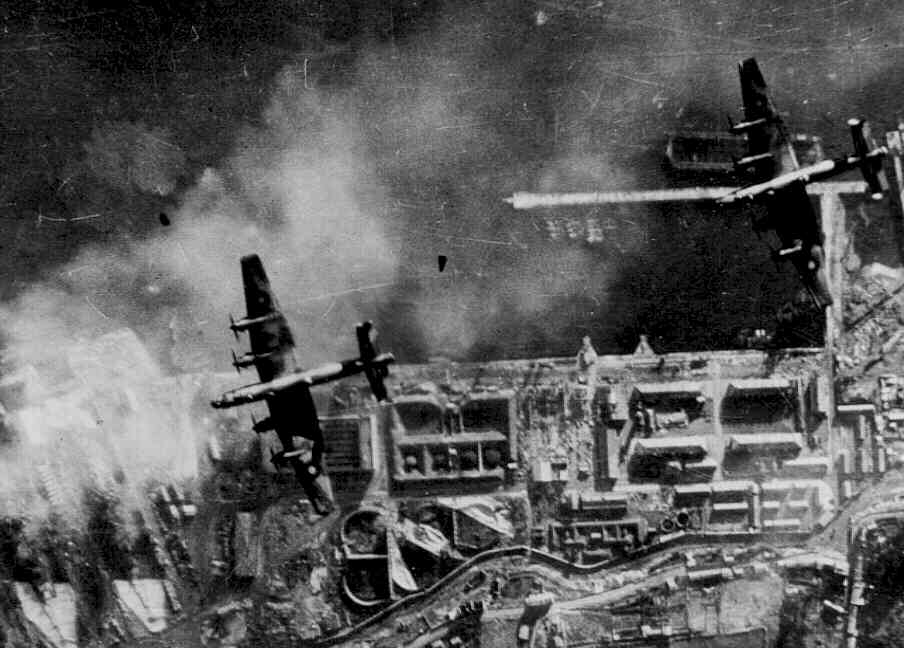
A daylight raid in December 1941 on Brest "(c) Crown Copyright/Mod"
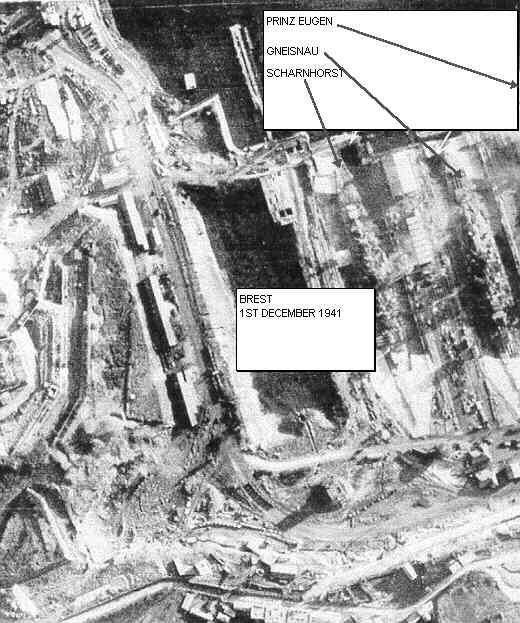
"(c) Crown Copyright/Mod"
After this raid Clarence was made "Skipper" and in command of his own Whitley V bomber. The night raids continued.
13th June Dortmund
15th June Dusseldorf Main Railway Station
17th June Cologne Post Office
19th June Dusseldorf
24th June Cologne Telephone Exchange
3rd July Essen Marshalling Yard
7th July Osnabruck - west end of Marshalling Yard
9th July Aachen Main Post Office
14th July Bremen Old Town
On the 1st August 1941, Clarence was transferred to 76 Squadron at Middleton Saint George. He continued to fly night raids, as skipper. However, he now flew Halifax I bombers.
76 Squadron had been re-formed from "C" Flight of 35 Squadron at Linton-on-Ouse, near York in April 1941. They were the first main-force Squadron in 4 Group Bomber Command to be equipped with the Halifax 1 four engined bomber.
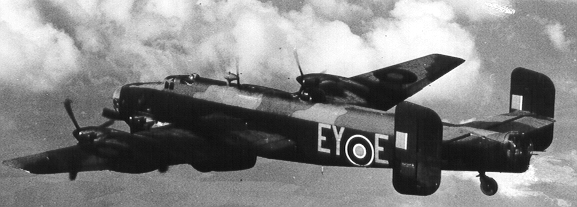
"(c) Crown Copyright/Mod"
After a couple of months "working up" to Operational standards, they began operating from Middleton Saint George, County Durham in June 1941.
At this time, aircraft and trained crews were at a premium and on the Berlin raid of the 12/13th August, on which Sergeant Whitfield's crew was lost, the Squadron managed to despatch 7 aircraft. This was only the second time that that number had been reached. Later in the war, 76 Squadron would become a 3 Flight Squadron able to put up 20 to 25 aircraft on the mass raids of 1943 to 1945. The target had been Friedrichstrasse Station in Berlin for this raid, where Clarence failed to return.
The total force raiding Berlin that night was 70. It was not a successful raid for a variety of reasons. 76 Squadron's record that night read :-
number despatched 7
number attacked 2
alternative target 1
Duty Not Carried Out 1
Failed to Return 2*
In effect the number, who "Failed To Return" was 3, as Sergeant McHale's aircraft crashed in Middleton's circuit on return, while attempting a landing. All 7 members of the crew were killed.
Besides Clarence's and Sergeant McHale's loss, the other who "Failed to Return" was L- Love piloted by Flight Lieutenant Christopher Cheshire. He was the brother of Group Captain Leonard Cheshire VC. Of Christopher Cheshire's crew; 2 died and 5 became POWs. Christopher survived and went on to outlive his more famous brother. He became a tobacco farmer in Spain.
Clarence was pilot of Halifax, L9531 that night. His fate is described in 76 Squadron's Operational History, "To See the Dawn Breaking" by W.R. Chorley (1981):-
".... Whitfield, it turned out, suffered the cruelest stroke of misfortune. Proceeding SSE of Bremerhaven his aircraft came under sustained attack from a night-fighter flown by Lieutenant Autenrieth of 6/NJG 1. Set on fire, Sergeant Whitfield ordered his crew to bale out. Evidence clearly shows that all were successful in obeying his instruction. Tragically five, including Sergeant Whitfield, fell into a marsh near Wittstadt and all were drowned. The two survivors, Sergeant Kenworthy, who in the July had been wounded on operations to Mersberg and Flight Sergeant Bone were soon picked up by the authorities . Sergeant Bone never saw England again. Less than a month before the end of the war in Europe ended, he died, possibly as the result of an erroneous strafing attack by Allied fighters on a column of prisoners being forced marched by the retreating German forces".
A truly harrowing story.
This raid was only Clarence's second after joining 76 squadron. Previously, on the night of the 7th July, he had been part of a force that had attacked Krupp's Works at Essen.


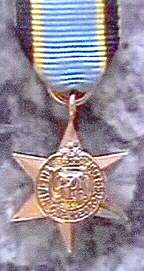
Clarence was awarded the 1939-45 Star , the 1939-45 War Medal and the Aircrew Europe Star.
There are a number of memorials to him :-
The Old General Post Office in Colchester , where he was employed pre-war, had one. This has been removed and re-dedicated at the Royal Mail Depot at Eastgate , Colchester.
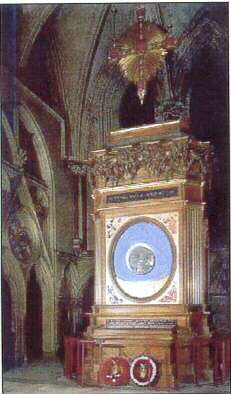
He is also listed on the Memorial in York Minster. This takes the form of the Astronomical Clock with a book listing all the fallen airmen belonging to the squadrons operating out of Yorkshire, Northumberland and Durham.
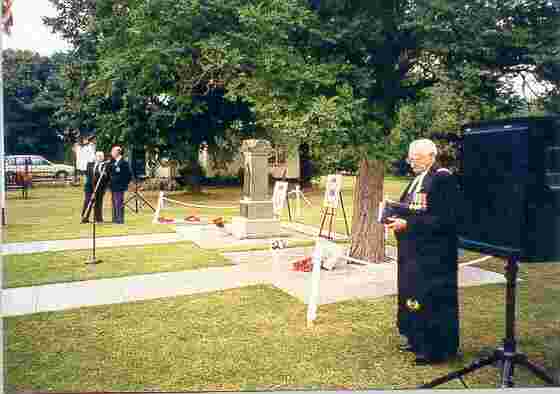
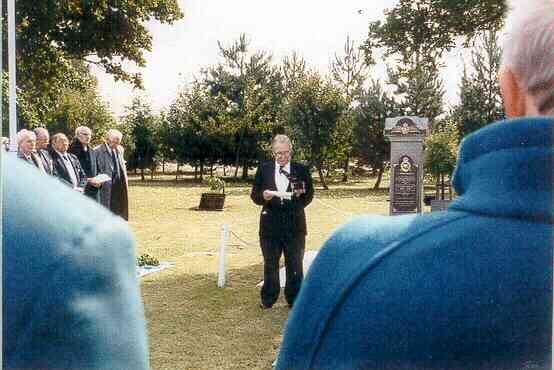
Sergeant Whitfield and his crewmates are honoured together with a further 780 aircrew of 76 Squadron, by a fine granite and marble Memorial at the entrance to the last base of the Squadron, RAF Station Holme-on-Spalding Moor in East Yorkshire. The Memorial to the right of 76 Squadron's is to 458 Squadron Royal Australian Air Force, who were based at Holme - on - Spalding Moor before 76 squadron in 1942. The 458 squadron Memorial depicts a Eucalyptus tree. Both are now cared for together by 76 Squadron Association.
In All Saint's Church, in the village of Holme-on-Spalding Moor (The Church on the Hill), the Squadron Association has placed a stained glass window in memory of their comrades "who didn't make it back" and the names of every one of them is inscribed in a Book of Remembrance in the same Church. The Church on the Hill has specific significance to 76 Squadron. The area around that part of Yorkshire is fairly flat with this hill sitting up proud above the plains around. A red beacon was placed on the tower of the church on the hill to guide 76 squadron home to their base after a raid.
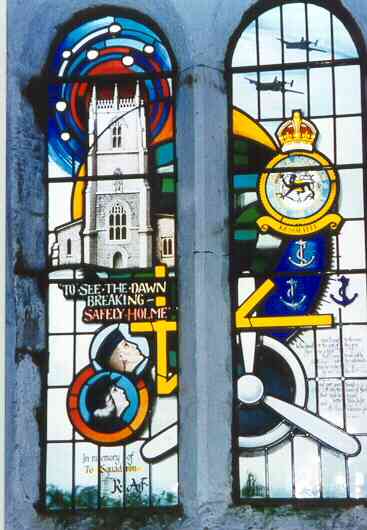
76 Squadron RAF -Memorial Window All Saints, Holme-on Spalding Moor.
The Squadron badge is shown prominently in the right-hand light of the window and below it are shown three anchors. These are a reminder of the losses suffered during action against the German capital ships:- Scharnhorst, Gneisenau and Tirpitz.
All Saints Church itself is depicted in the left-hand light, with the red beacon shining from the tower against a lightening night sky, in which are shown a handful of stars.
The main central area of the design is composed of two large interlinked circles. The upper edge of the top circle represents the sun rising, ("dawn breaking"), and the lower edge of the lower circle is marked as for a compass rose. the central area represents the landscape of Yorkshire, in which the Church sits, for the airfield of Holme-on-Spalding Moor, and for which (as part of our country) our armed forces fought and in some cases lost their lives.
At the top of the right-hand light are shown two Halifax bombers returning from Operations, guided in over the early morning fields towards the airfield by the red beacon.
The Hercules radial engine is shown at the base of the right-hand light and balancing on the left, the up-turned faces of two ground- crew, awaiting the returning aircraft. The words " TO SEE THE DAWN BREAKING - SAFELY HOLME" (this is the title of the Squadron's History) are shown between the Church and their faces.
The yellow lines in the lower half of each light depict the runways of the airfield.
An extract from a poem by Minnie Louise Haskins (b1874 - d1957) is written on the lower part of the right-hand light and the words "In memory of 76 Squadron R. A. F." are at the base of the left-hand light.
The text of the poem is an extract from "God Knows" and is as follows :-
"And I said to the man, who stood at the gate of the year :
' Give me a light that I may tread safely into the unknown'.
And he replied :
'Go out into the darkness and put your hand into the hand of God.
That shall be to you better than light and safer than a known way'."
This window was dedicated on September 4th 1994. The design is by Ann Sotheran of York.
There was a very close relationship between members of the same crew. Therefore let us remember in our prayers those others, who flew with Clarence and subsequently died on Active Service. Fittingly, five of them lie in graves side by side:-
John James Berry, Sergeant 1166613. He was a pilot aged 21 and the son of Reginald and Ada Berry of Swindon. He lies in grave 21. A. 4. at Becklingen War Cemetery
Victor Digby Durham, Pilot Officer 64280, who was the observer and aged 22.
He was the son of Charles and Beatrice Durham of Wealdstone, Harrow. He lies in grave 21. A.3.
Alfred Critchlow, Sergeant 978005, who was the wireless operator/air gunner. He lies in grave 21.A.2
Norman Frederick Brotherton, Sergeant 956849, who was wireless operator/ air gunner aged 21. He was the son of Lillian Brotherton of Wolverhampton.
and William Andrew Bone, Warrant Officer 581434 was the son of William & Mary Bone, of Hunts Cross, Liverpool. He is buried in the Berlin 1939-45 War Cemetery, Brandenburg, Germany. He was aged 24 when he died.
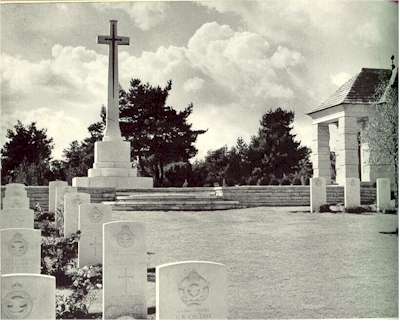
Clarence is buried in Becklingen War Cemetery in Germany. Grave 21 A.5. The Cemetery is 13 kilometres South East of Soltau on the West side of the road from Hamburg to Hannover.
Clarence was one of a group of 5 friends, who all worked as sorting clerks and telegraphists at the Colchester Post Office. Edward Bond and Douglas Hatherly were to survive the war. Douglas serving as a radio operator in the Royal Navy mainly on a minesweeper H. M. S. Alfredian.
However, L/Cpl Henry Cecil Kirk died with 10 Corps. Signals, Royal Corps of Signals and has no known grave but is commemorated on panel 51 of the Alamein Memorial in Egypt. He was 24 and died on Saturday 14th November 1942.
Terence Jack Priddle, like Clarence was a Flight Sergeant with the RAFVR. He came from Lexden and flew with 15 Squadron Bomber Command. He was a tail gunner and died aged 22 on Sunday 5th November 1944 over Germany. He lies in Grave 6 E. 8 in the Rheinberg War Cemetery.
REFERENCES
Information obtained from The Commonwealth War Graves web site. www.cwgc.org/ & the Air Historical Branch (RAF), MOD, 76 "Squadron Association" and from his sister, Mrs. MayThe image of the Astronomical Clock is used with the kind permission of the Dean & Chapter of York Minster.
The pictures of the medals were kindly provided by Worcestershire Medal Service Ltd.
The photographs of Brest & the aircraft are "(c) Crown Copyright/Mod" and used with their kind permission.
11/09/02 last updated
**********************************************************
These pages are dedicated to the memory of the Fallen from the two World Wars, who lived in Abberton & Langenhoe.. Prepared by Saint Andrew's Parochial Church Council. November 11th 2000